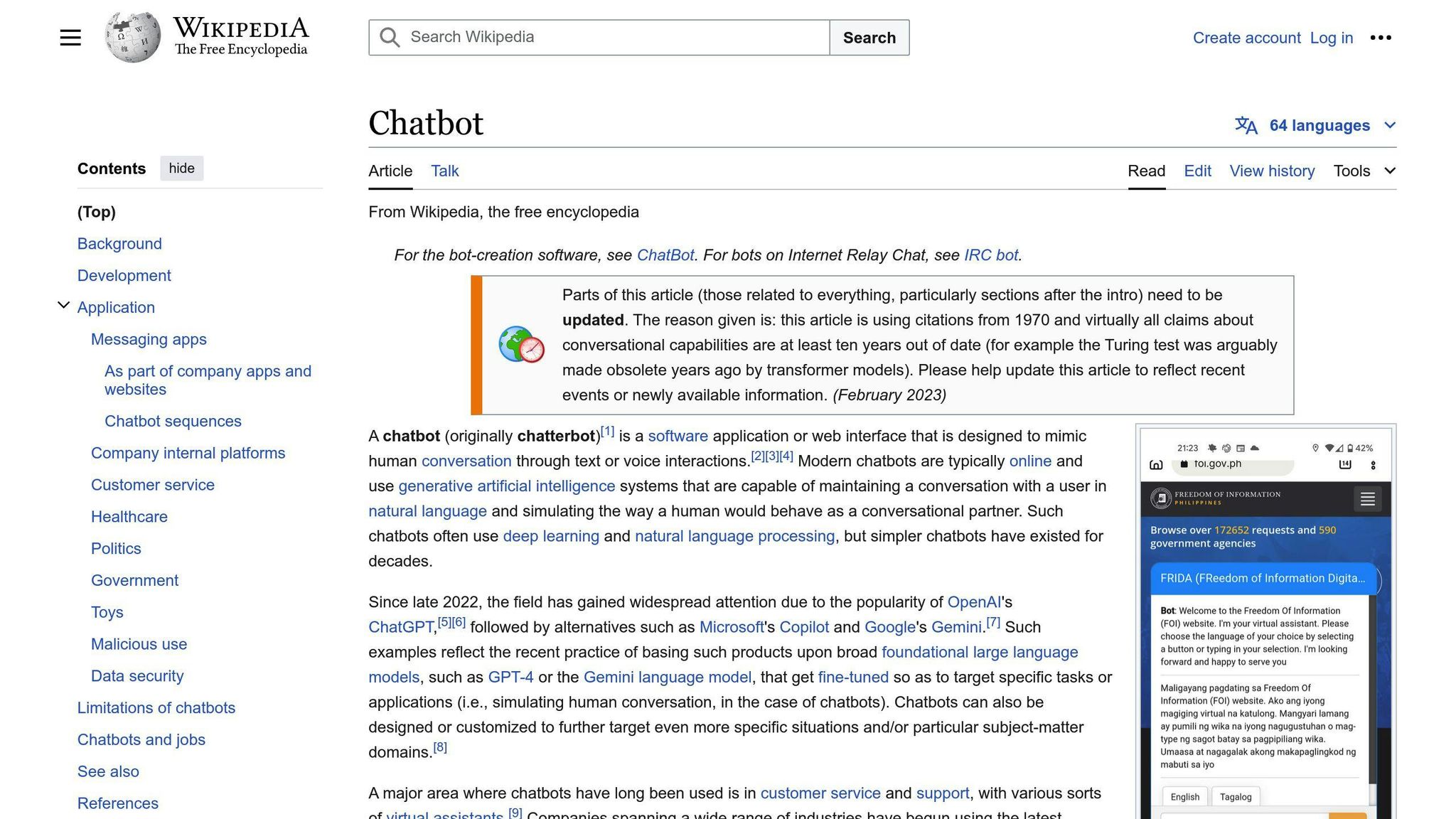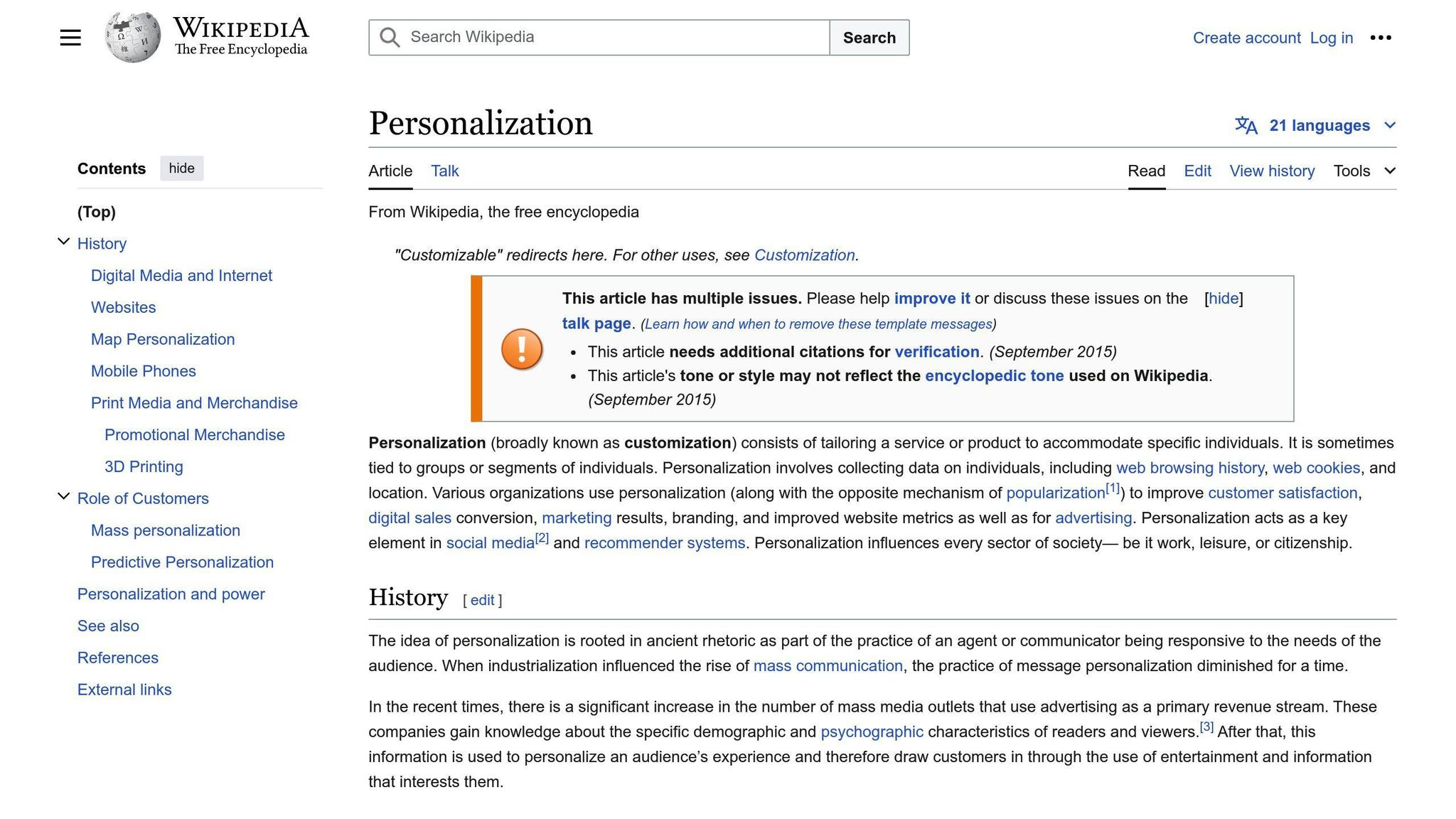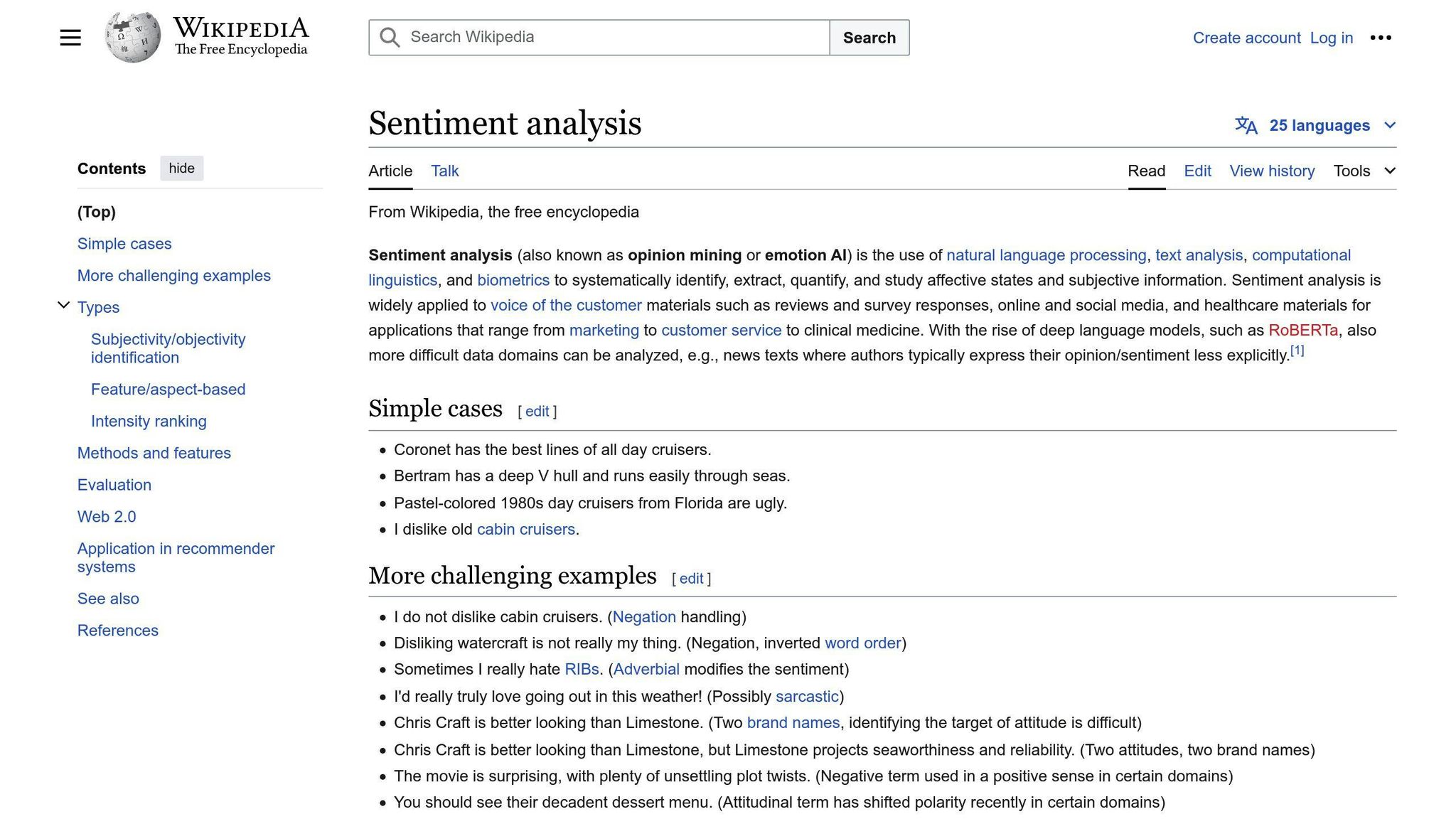10 Ways AI Optimizes Ecommerce User Onboarding
AI transforms ecommerce user onboarding by:
- Tailoring User Journeys - Creating personalized onboarding flows based on user behavior, preferences, and goals.
- AI-Powered Chatbots - Offering 24/7 assistance with tailored guidance, efficient support, and interactive learning.
- Predicting User Behavior - Analyzing data to understand user needs and create customized onboarding programs.
- Automated Feedback - Collecting and analyzing customer feedback to refine the onboarding process.
- Targeted Email Marketing - Delivering personalized email content based on user behavior and interests.
- Content Personalization - Generating tailored content that resonates with individual users.
- Tracking User Progress - Monitoring user interactions to provide guidance and streamline onboarding.
- Sentiment Analysis - Understanding customer feedback and sentiments for continuous improvement.
- Optimized Search - Providing personalized search results based on user intent and preferences.
- Data Collection and Analysis - Gathering user data to create tailored experiences and identify areas for process optimization.
By leveraging AI, ecommerce businesses can deliver smooth, personalized onboarding experiences that boost engagement, conversions, and customer loyalty.
Related video from YouTube
1. Tailored User Journeys
AI helps create customized onboarding experiences for each user. By analyzing user behavior, preferences, and goals, AI can offer personalized onboarding flows that address specific needs and interests.
Personalization
AI-powered personalization allows ecommerce sites to provide unique onboarding experiences. For example, a user signing up for a project management tool may see an onboarding journey focused on setting up a new project, inviting team members, and establishing timelines.
Efficiency
Personalized onboarding journeys streamline the process by highlighting essential features and functionalities. This reduces the time for users to complete onboarding, increasing the chances of conversion and retention.
Data-Driven Insights
AI-driven personalized onboarding provides valuable data insights that businesses can use to refine their strategies. By analyzing user behavior and feedback, businesses can identify areas for improvement, optimize onboarding flows, and create better user experiences.
| Benefit | Description |
|---|---|
| Personalization | Offer unique onboarding experiences tailored to individual user needs and preferences. |
| Efficiency | Streamline the onboarding process by focusing on essential features and functionalities. |
| Data-Driven Insights | Gain valuable data insights to refine onboarding strategies and improve user experiences. |
2. AI-Powered Chatbots for Quick Help

AI chatbots offer 24/7 assistance to users during onboarding. They provide a personalized experience and save time by automating routine tasks.
Tailored Guidance
Chatbots can access user data to offer customized onboarding. They gather information through conversations or by importing data from your systems. This allows them to provide relevant guidance, making users feel understood and more likely to engage.
Efficient Support
Chatbots can handle common questions and basic onboarding tasks automatically. This reduces the workload for human support teams, allowing them to focus on complex issues and improve response times.
Interactive Learning
AI chatbots create an engaging and interactive onboarding experience. By providing clear instructions and guidance, they help users get started quickly, reducing frustration and increasing the chances of conversion and retention.
| Benefit | Description |
|---|---|
| Tailored Guidance | Offer personalized onboarding based on user data and preferences. |
| Efficient Support | Automate routine tasks, reducing workload for human support teams. |
| Interactive Learning | Create an engaging experience, helping users get started quickly. |
3. Predicting User Behavior for Better Onboarding
Predictive analytics helps ecommerce businesses understand how users interact with their products or services during onboarding. By analyzing user data, businesses can tailor the onboarding experience to each individual, ensuring a smooth and efficient adoption process.
Understanding User Needs
Predictive analytics provides insights into user behavior, allowing businesses to identify areas where users may struggle or lose interest during onboarding. By analyzing user interactions, businesses can refine the onboarding process to address specific needs and preferences.
Personalized Onboarding
With predictive analytics, businesses can create customized onboarding programs for each user. By analyzing historical data, businesses can predict potential challenges and tailor the onboarding experience accordingly. This personalized approach ensures a smoother adoption of products or services.
Efficient Onboarding
Predictive analytics helps optimize the onboarding process, reducing the time and effort required for users to get started. By identifying potential roadblocks, businesses can proactively provide targeted guidance, ensuring a more efficient onboarding experience.
| Benefit | Description |
|---|---|
| User Insights | Gain insights into user behavior to refine the onboarding process. |
| Personalization | Create tailored onboarding programs for individual users. |
| Efficiency | Optimize the onboarding process, reducing time and effort for users. |
4. Automated Feedback Collection and Analysis
Gathering User Insights
Collecting and analyzing customer feedback is crucial for optimizing the ecommerce user onboarding process. By leveraging AI-powered tools, businesses can gather feedback from various sources like surveys, reviews, and social media. This provides valuable insights into user sentiments, preferences, and pain points.
Streamlining the Process
Automated feedback collection and analysis tools save time and resources. AI can quickly and accurately analyze large volumes of data, providing actionable insights to improve the onboarding experience.
Boosting User Engagement
By analyzing customer feedback, businesses can identify areas where users may struggle or lose interest during onboarding. This allows them to refine the process, addressing specific needs and preferences, leading to higher user engagement and satisfaction.
| Benefit | Description |
|---|---|
| User Insights | Gain insights into user sentiments, preferences, and pain points. |
| Efficiency | Streamline the process of gathering and analyzing feedback, saving time and resources. |
| User Engagement | Refine the onboarding process to address specific needs, leading to higher user satisfaction. |
Continuous Improvement
Automated feedback collection and analysis enable businesses to continuously improve their onboarding process. By regularly gathering and analyzing user feedback, they can identify areas for improvement and make data-driven decisions to enhance the user experience.
| Benefit | Description |
|---|---|
| Continuous Improvement | Regularly gather and analyze user feedback to identify areas for improvement. |
| Data-Driven Decisions | Make informed decisions based on user feedback to enhance the onboarding experience. |
5. Targeted Email Marketing Using User Behavior
Targeted email marketing allows businesses to deliver personalized content to customers based on their behavior, preferences, and interests. By leveraging AI, ecommerce companies can analyze user data to create tailored email campaigns that resonate with their audience.
Personalized Content
AI-powered behavioral targeting enables businesses to create highly personalized email content tailored to specific customer needs and interests. For example, a clothing retailer can send product recommendations to customers based on their browsing history, purchases, and search queries. This personalized approach increases engagement, conversion rates, and customer loyalty.
Efficient Campaigns
Behavioral targeting streamlines the process of creating and sending targeted email campaigns. AI algorithms can quickly analyze large volumes of customer data, identify patterns, and automate the creation of personalized email content. This saves time and resources, allowing businesses to focus on other critical operations.
Boosted Engagement
Targeted email marketing helps boost user engagement by delivering relevant and timely content that resonates with customers. By analyzing user behavior and preferences, businesses can create email campaigns that address specific interests and needs. This approach increases open rates, click-through rates, and conversion rates, leading to higher customer satisfaction and loyalty.
| Benefit | Description |
|---|---|
| Personalized Content | Create tailored email content based on customer needs and interests. |
| Efficient Campaigns | Streamline the process using AI algorithms to analyze data and automate personalization. |
| Boosted Engagement | Deliver relevant content that resonates with customers, increasing open rates and conversions. |
sbb-itb-be22d9e
6. Content Personalization and Generation

Tailoring content to individual customers and automating content creation are key aspects of AI-optimized ecommerce user onboarding. By utilizing AI, businesses can develop content that resonates with their audience, boosting engagement and conversion rates.
Personalized Content
AI-powered content personalization allows businesses to create targeted content that addresses specific customer needs and interests. For example, a fashion retailer can use AI to generate product recommendations based on a customer's browsing history, purchases, and search queries. This personalized approach increases the likelihood of customers engaging with the content and making a purchase.
Efficient Content Creation
AI-driven content generation streamlines the process of creating and delivering personalized content. AI algorithms can quickly analyze large volumes of customer data, identify patterns, and automate the creation of tailored content. This saves time and resources, allowing businesses to focus on other critical operations.
Increased Engagement
Personalized content has been shown to increase user engagement, with customers more likely to interact with content that aligns with their interests and needs. AI-powered content personalization can help businesses boost engagement, conversion rates, and customer loyalty.
| Benefit | Description |
|---|---|
| Personalized Content | Create tailored content that addresses specific customer needs and interests. |
| Efficient Content Creation | Use AI algorithms to analyze data and automate the creation of personalized content. |
| Increased Engagement | Boost engagement and conversion rates with personalized content that resonates with customers. |
7. Tracking User Progress with AI
AI-driven progress tracking allows businesses to monitor and analyze user behavior in real-time during the onboarding process. This helps identify areas for improvement and opportunities to optimize the experience.
Tailored Onboarding
By analyzing user interactions, AI algorithms can identify where individuals may need additional guidance or support. This enables businesses to provide the right content at the right time, ensuring a smooth onboarding experience tailored to each user.
Streamlined Process
Automating user behavior tracking and analysis streamlines the onboarding process, reducing the time and resources required to onboard new users. This allows businesses to focus on other critical operations.
Data-Driven Insights
AI-driven progress tracking provides valuable insights into user behavior and preferences. By analyzing this data, businesses can identify trends and patterns, enabling data-driven decisions to optimize the onboarding process and improve user engagement.
| Benefit | Description |
|---|---|
| Tailored Onboarding | Provide personalized guidance and support based on individual user behavior. |
| Streamlined Process | Automate tracking and analysis, reducing time and resources for onboarding. |
| Data-Driven Insights | Gain insights into user behavior and preferences to optimize the onboarding process. |
8. Sentiment Analysis for Continuous Improvement

Analyzing customer feedback and sentiments is crucial for improving the ecommerce user onboarding process. By understanding how customers feel, businesses can identify areas that need improvement and make data-driven decisions to enhance the onboarding experience. This continuous improvement approach allows ecommerce companies to refine their onboarding strategies and implement iterative enhancements.
Understanding Customer Feedback
Sentiment analysis provides insights into customer behavior and preferences. By analyzing this data, businesses can identify trends and patterns, enabling data-driven decisions to optimize the onboarding process and improve user engagement.
For example, analyzing feedback from an unsatisfied mobile user can reveal whether they're confused, frustrated, or even planning to switch to a competitor. This allows businesses to prioritize changes and actions to address the issue:
| User Sentiment | Potential Action |
|---|---|
| Confused about accessing features | Improve interface or product tour |
| Frustrated and considering switching | Reach out with an apology, discount, or incentive to retain the customer |
9. Optimized Search and Navigation
Quick and Easy Browsing
AI-powered search engines make it simple for users to find what they need on ecommerce sites. By understanding user intent and providing personalized results, these search tools streamline the browsing process. Users can quickly locate relevant products or content, reducing frustration and bounce rates.
Tailored to Your Interests
AI search engines also offer personalized results based on your browsing history and preferences. If you frequently search for a specific brand or product category, the AI will prioritize those items, making it easier to find what you want.
Insights for Improvement
By analyzing search behavior and patterns, businesses gain valuable insights into customer needs and interests. This data helps refine the onboarding process, identify areas for improvement, and inform product development and marketing strategies.
For example, if users often search for a particular product feature, the business can prioritize that feature in marketing campaigns or product roadmaps.
| User Behavior | Potential Action |
|---|---|
| Frequent searches for a product feature | Highlight the feature in marketing, consider adding it to the product |
| Searches for a specific brand | Prioritize that brand's products in search results |
| Difficulty finding a product category | Improve category navigation and organization |
10. Automated Data Collection and Analysis
Personalized Onboarding
Collecting user data during onboarding allows companies to create tailored experiences. By analyzing this data, businesses can understand users' needs, preferences, and goals. This information helps recommend relevant features or tools, making the onboarding process more personalized.
Streamlined Process
Automated data analysis identifies areas for improvement in the onboarding process. This reduces the time and effort required for new users to get started, leading to a faster and smoother experience. Higher user engagement and retention rates result from a more efficient onboarding.
Data-Driven Insights
User data collected during onboarding provides valuable insights into behavior and preferences. Analyzing this data reveals trends and patterns that can inform product development and marketing strategies.
| User Behavior | Potential Action |
|---|---|
| Frequent searches for a product feature | Highlight the feature in marketing, consider adding it to the product |
| Difficulty finding a product category | Improve category navigation and organization |
| High bounce rates during onboarding | Simplify the process, provide clearer instructions |
Conclusion
In today's ecommerce world, providing a smooth and tailored user onboarding experience is key to driving engagement, keeping customers, and boosting revenue. By using AI, ecommerce businesses can optimize their onboarding processes, improve user satisfaction, and stay ahead of competitors.
The 10 ways discussed in this article show the vast potential of AI in transforming the onboarding experience:
1. Tailored User Journeys
AI creates customized onboarding flows based on user behavior, preferences, and goals. This streamlines the process by highlighting essential features.
2. AI-Powered Chatbots for Quick Help
Chatbots offer 24/7 personalized assistance, automating routine tasks and allowing human support teams to focus on complex issues.
3. Predicting User Behavior for Better Onboarding
Predictive analytics helps understand how users interact during onboarding, enabling businesses to tailor the experience to individual needs.
4. Automated Feedback Collection and Analysis
AI tools gather and analyze customer feedback, providing insights to refine the onboarding process and boost user engagement.
5. Targeted Email Marketing Using User Behavior
AI-powered behavioral targeting enables personalized email content tailored to specific customer interests and needs.
6. Content Personalization and Generation
AI creates targeted content that addresses individual customer needs and interests, increasing engagement and conversions.
7. Tracking User Progress with AI
Real-time monitoring of user behavior during onboarding helps identify areas for improvement and opportunities to optimize the experience.
8. Sentiment Analysis for Continuous Improvement
Understanding customer feedback and sentiments through AI allows businesses to make data-driven decisions to enhance the onboarding experience.
9. Optimized Search and Navigation
AI-powered search engines provide personalized results based on user intent and preferences, streamlining the browsing process.
10. Automated Data Collection and Analysis
Collecting and analyzing user data during onboarding enables businesses to create tailored experiences and identify areas for process improvement.
As the ecommerce industry evolves, it's crucial for businesses to stay up-to-date with AI solutions and strategies to improve their onboarding experiences. By doing so, they can create loyal customers, drive growth, and maintain a competitive edge.
FAQs
How can AI help with customer onboarding?
AI can analyze customer data and behavior to create a personalized onboarding experience for each user. Using machine learning, AI identifies the most relevant features, tools, or services for individual customers based on their industry, company size, or usage patterns. This allows businesses to tailor the onboarding process to meet each customer's unique needs, increasing engagement and long-term satisfaction.
| Customer Data | Personalized Onboarding |
|---|---|
| Industry | Highlight relevant features and tools |
| Company Size | Recommend suitable services and plans |
| Usage Patterns | Suggest features based on common tasks |
By leveraging AI, businesses can:
1. Analyze Customer Data
- Gather information on industry, company size, and usage patterns
- Identify trends and preferences
2. Personalize Onboarding
- Recommend relevant features, tools, and services
- Tailor the process to individual customer needs
3. Increase Engagement
- Provide a tailored experience for each customer
- Improve long-term satisfaction and retention
How does AI help improve the onboarding process?
AI can automate data collection and analysis during onboarding, providing insights to streamline and personalize the process. By understanding user behavior and preferences, businesses can:
- Identify areas for improvement
- Recommend relevant features or tools
- Simplify the onboarding steps
- Provide clearer instructions
This leads to a faster, smoother onboarding experience, resulting in higher user engagement and retention rates.
Add a New Sales Channel
- • Digital downloads
- • Courses & tutorials
- • Visual & audio assets
- • Game credits or licenses
- • Private memberships

